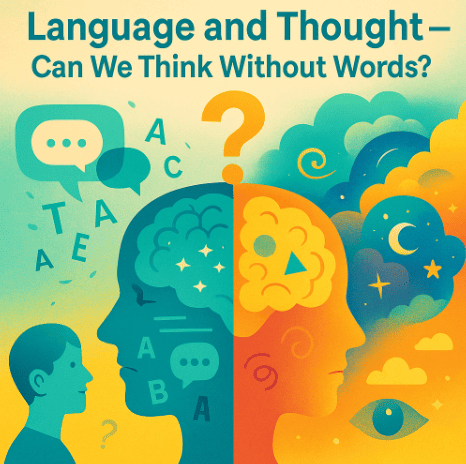
Recap of Lesson 3: The Mystery of Consciousness – Why Are We Aware?
In our last lesson, we explored consciousness—the strange fact that we are aware of our experiences. We learned about levels of consciousness, theories like the Global Workspace Theory and Integrated Information Theory, and we met the “hard problem”: why does information processing feel like anything at all?
Now, we move to something equally mysterious: the relationship between language and thought.
Part 1: What Is Language?
Language is more than words. It is a system of symbols (sounds, gestures, or written marks) that we use to communicate ideas.
For example:
-
The sound “dog” is just vibrations in the air, but it connects in your brain to the concept of a furry, four-legged animal 🐕.
-
A written word like “tree” is just marks on paper, but your brain turns it into the image of a tall plant 🌳.
Language lets us share thoughts with others, but it also seems to shape how we think ourselves.
Part 2: The Language Areas of the Brain
Scientists have discovered special regions of the brain for language:
-
Broca’s area (in the frontal lobe) – helps produce speech and grammar. Damage here causes difficulty speaking.
-
Wernicke’s area (in the temporal lobe) – helps understand meaning of words. Damage here makes speech fluent but nonsensical.
-
Angular gyrus – helps connect written words with meaning.

Together, these regions form a network that turns thoughts into words and words back into thoughts.
Part 3: The Sapir–Whorf Hypothesis – Does Language Shape Thought?
In the 20th century, linguists Edward Sapir and Benjamin Lee Whorf proposed a bold idea: the language you speak shapes the way you think.
For example:
-
The Hopi people of North America describe time differently than English speakers, focusing on cycles rather than past/present/future. Some researchers argued this made them experience time differently.
-
Russian speakers have two different words for “blue,” and studies show they are quicker than English speakers at telling apart shades of blue.
-
In some Aboriginal Australian languages, people describe space using cardinal directions (“north, south”) instead of “left, right.” As a result, they are incredibly good at keeping track of direction.
So, does language change thought, or just influence it? Most scientists today think: language doesn’t fully control thought, but it does shape how we pay attention to the world.
Part 4: Can We Think Without Words?
Let’s test this question.
Babies 👶
Before babies learn words, they still think. They recognize faces, expect objects to continue existing when hidden, and feel joy or fear. This shows that some thought exists without language.
Animals 🐒🐬🐦
-
Monkeys remember locations of food and tools.
-
Dolphins communicate with whistles and show problem-solving.
-
Crows use tools to get food.
These are all forms of thought without human language.
Silent Thinking
Even adults sometimes think without words—when imagining a melody 🎶, a picture 🖼️, or a movement 🏃. Artists, musicians, and athletes often think in images, patterns, or motions rather than sentences.
This is called nonverbal thought.
Part 5: But Language Supercharges Thought
While thought without language is possible, language makes thinking more powerful.
-
Abstract thinking – With words, we can imagine things we’ve never seen, like “democracy” or “infinity.”
-
Complex planning – Words let us hold ideas in working memory, organize them, and share them with others.
-
Cultural knowledge – Language lets humans pass wisdom, science, and stories across generations.
Without language, we would still think, but our thoughts would be limited to the here and now. Language gives us the ability to build civilizations.
Part 6: The Inner Voice
Have you noticed a voice in your head when you read silently or plan what to say? That’s your inner speech.
Scientists think inner speech helps with:
-
Self-control (“Don’t forget your homework!”).
-
Problem-solving (working through steps silently).
-
Memory (rehearsing information).
People who lose the ability to produce speech (from brain damage) often still think, but they may find certain kinds of complex planning harder.
Part 7: What Happens in Silence?
Meditators often try to quiet the inner voice. Some describe reaching states where there are no words—just pure awareness.
This suggests consciousness does not require language, though language colors much of our everyday awareness.
Recap
In this lesson, we learned:
-
Language is a system of symbols connecting words to meaning.
-
Brain areas like Broca’s and Wernicke’s areas are key for language.
-
The Sapir–Whorf hypothesis says language influences thought.
-
Babies, animals, and adults can think without words—through images, sounds, and actions.
-
Language supercharges thought, making abstract reasoning, planning, and culture possible.
-
Inner speech helps with memory, problem-solving, and self-control.
-
Consciousness can exist without language, but language transforms its power.